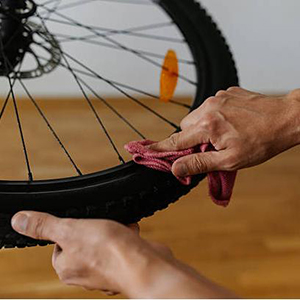
Carbon Bike Parts Guide
When selecting a high-performance bike, carbon bike parts play a crucial role in enhancing speed, stiffness, and comfort. From carbon frames to carbon bike wheels, each component impacts your cycling experience. Understanding the different carbon fiber components and how they contribute to your bike’s performance will help you make the best choice for your needs.
What Are Carbon Bike Parts?
Carbon bike parts are components made from carbon fiber, a lightweight and extremely strong material used in bicycles. These parts include frames, wheels, handlebars, forks, seatposts, and pedals. Carbon fiber allows each part to be stiff yet light, improving the bike’s performance and efficiency. Unlike traditional metal components, carbon parts can absorb vibrations while maintaining strength, giving a smoother and more responsive ride.
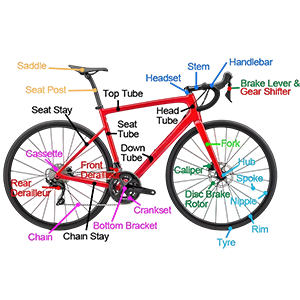
Carbon Bike Frames
Carbon frames are the foundation of any high-performance bike. Understanding the types, materials, and geometry of these frames helps you select the right option for your needs.
Carbon Bike Wheel Parts
When you upgrade to carbon bike wheel parts, you reduce weight and improve responsiveness. Let’s explore the key components, types, and advantages of carbon wheels so you can choose the best setup for your bike.
Anatomy of Carbon Wheels
Carbon wheels are made up of several key parts: carbon rims, hubs, carbon spokes, and nipples. The rim is usually the most visible carbon component, providing stiffness and aerodynamic benefits. Hubs house the bearings and interface with the drivetrain, while spokes transfer power from the hub to the rim.
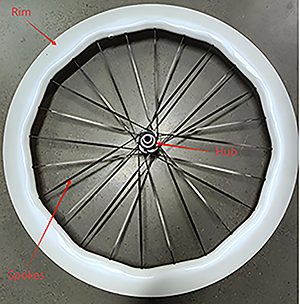
Carbon Handlebars and Stems
The handlebars and stem are critical for control, comfort, and overall bike performance. Let’s take a closer look at the types, benefits, and how to select the right combination for your bike.
Types of Handlebars
Handlebars come in various shapes to suit different riding styles. Drop bars are common on road bikes for aerodynamic positioning, flat bars are popular for mountain bikes and hybrids, and bullhorn or riser bars offer versatile control for urban or gravel riding.
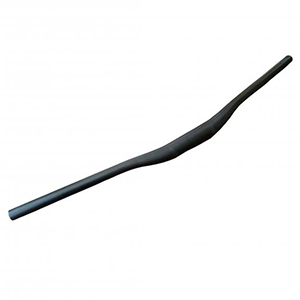
Carbon Forks and Suspension
The fork is a key part of your bike that affects handling, comfort, and performance. Choosing the right carbon fork can make a noticeable difference in ride quality.
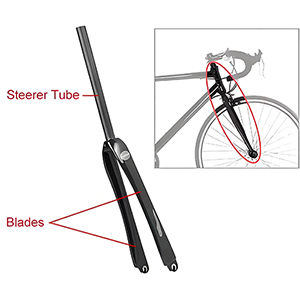
|
Feature |
Rigid Carbon Fork |
Suspension Fork |
|
Weight |
Lighter, less rotational mass |
Heavier due to suspension components |
|
Shock Absorption |
Minimal, relies on frame and tires |
Absorbs bumps and trail vibrations |
|
Maintenance |
Low |
Higher, requires regular servicing |
|
Best For |
Road, gravel, light commuting |
Mountain biking, rough terrain |
|
Performance Advantage |
Stiff, efficient power transfer |
Improved comfort and control |
Selecting the right fork depends on your bike type, terrain, and riding style. Road riders usually prefer lightweight, rigid carbon forks for efficiency, while mountain bikers need suspension forks for stability and shock absorption.
Drivetrain Components
The drivetrain is the heart of your bike’s performance. It transfers your pedaling power into forward motion, so every part, from the carbon crankset to the chain and derailleur, plays a vital role.
Cranksets and Bottom Brackets
Your crankset and bottom bracket determine how effectively your power reaches the wheels. Here’s a quick comparison between carbon and aluminum cranksets:
|
Feature |
Carbon Cranks |
Aluminum Cranks |
|
Weight |
Extremely lightweight |
Heavier than carbon |
|
Stiffness |
High torsional stiffness |
Moderate stiffness |
|
Power Transfer |
More efficient due to reduced flex |
Slightly less efficient |
|
Vibration Dampening |
Excellent at reducing road buzz |
Minimal vibration absorption |
|
Durability |
Strong but requires careful installation |
Highly durable, less prone to impact damage |
|
Feature |
Mechanical Derailleur |
Electronic Derailleur |
|
Shifting Method |
Cable-actuated |
Battery-powered and motor-driven |
|
Accuracy |
Good, may require tuning |
Highly precise, automatic trimming |
|
Maintenance |
Requires periodic cable adjustment |
Needs battery charging and software checks |
|
Performance |
Reliable and affordable |
Smooth, consistent shifting under load |
|
OEM Compatibility |
Easy to integrate across various setups |
Preferred for high-end or pro-level builds |
|
Feature |
Clipless Pedals |
Flat Pedals |
|
Connection |
Secure shoe engagement |
Freer foot movement |
|
Efficiency |
Better power transfer |
Moderate efficiency |
|
Material Options |
Carbon or alloy bodies |
Alloy or composite |
|
Best For |
Road and racing use |
Trail, gravel, and casual riding |
|
Carbon Advantage |
Lightweight, stiff, high responsiveness |
Durable but generally heavier |
Braking Systems
Brakes play a crucial role in how your bike feels and performs on the road or trail. Whether you’re climbing, descending, or maneuvering through tight corners, the right braking system ensures control and safety.
Rim Brakes vs Disc Brakes
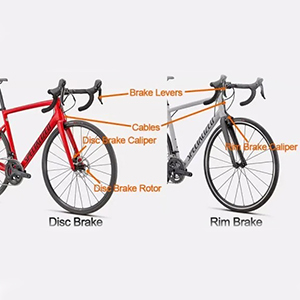
|
Feature |
Rim Brakes |
Disc Brakes |
|
Braking Power |
Moderate, depends on rim surface |
Strong and consistent in all conditions |
|
Weather Performance |
Reduced in rain or mud |
Excellent in wet or dirty environments |
|
Weight |
Lighter overall |
Slightly heavier due to rotors and calipers |
|
Maintenance |
Simple, low cost |
Requires more setup and occasional bleeding |
|
Heat Management |
Heat builds on rims |
Heat dissipates through rotors |
|
Feature |
Hydraulic Brakes |
Mechanical Brakes |
|
Power and Modulation |
Stronger, smoother control |
Adequate but less consistent |
|
Maintenance |
Needs fluid changes |
Easier cable maintenance |
|
Weight |
Slightly heavier |
Lighter overall |
|
Feel |
More responsive, less effort |
Requires more lever pull |
Saddles and Seatposts
Your saddle and seatpost directly affect how comfortable and efficient your ride feels. Choosing the right combination can help you stay balanced, reduce fatigue, and improve power transfer during long rides.
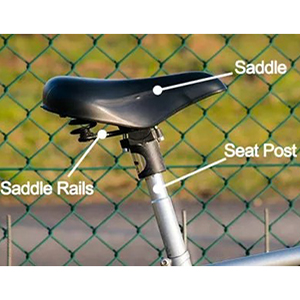
How to Choose the Right Carbon Bike Parts
Selecting the right carbon bike parts depends on how you ride and what you expect from your bike. Each component, from the frame to the wheels, affects your comfort, handling, and performance on the road or trail.
Consider Your Riding Style
For road cycling, prioritize lightweight, aerodynamic carbon components. For mountain biking, focus on durability and shock absorption with carbon suspension forks and sturdy wheels.
Budget and Brand Selection
Different brands use different carbon layup techniques and resins, which influence performance and cost. Set a realistic budget and look for reputable manufacturers known for quality testing and OEM support.
Compatibility and Fit
Always ensure that your chosen carbon parts fit your frame and drivetrain system. Even small mismatches, like stem diameter or bottom bracket size, can affect performance and safety.
Latest Carbon Bike Innovations
Modern carbon parts now feature EPS molding, aerodynamic shaping, and vibration-dampening tech for improved comfort and strength. Staying informed about new designs helps you choose components that match current industry standards and future trends.
Maintenance and Care for Carbon Components
Proper maintenance ensures your carbon bike parts last longer and perform at their best. With a few simple habits, you can keep every component—from your carbon frame to your wheels—in top condition.
Cleaning Carbon Parts
Use mild soap and water to clean carbon surfaces. Avoid harsh chemicals or high-pressure washers that could weaken the resin or scratch the finish. A soft microfiber cloth is ideal for wiping dirt and grime without damaging the surface.
